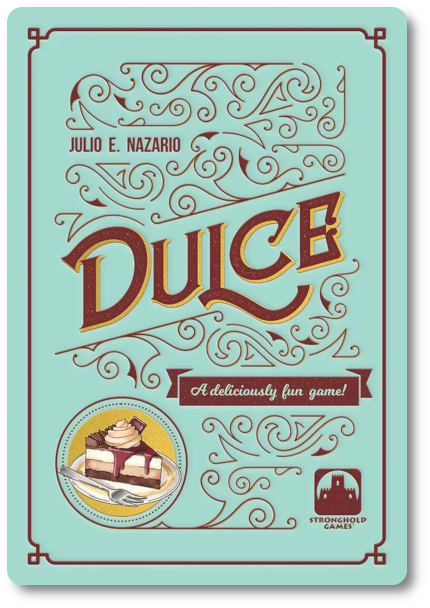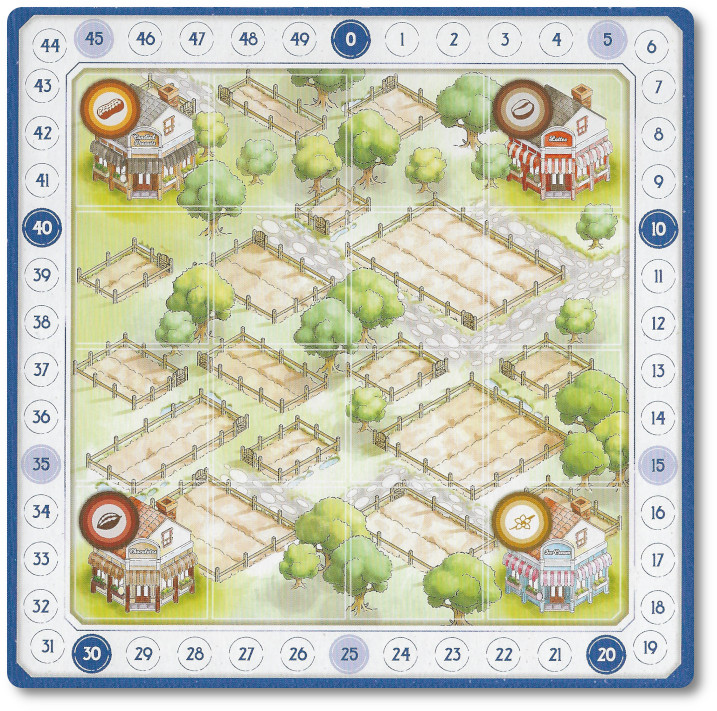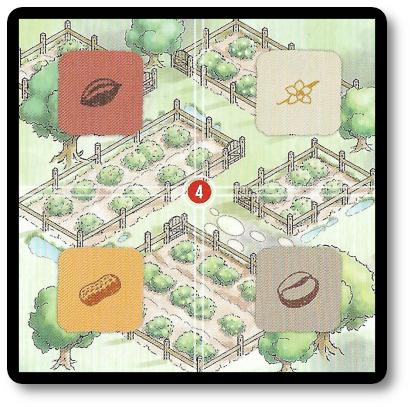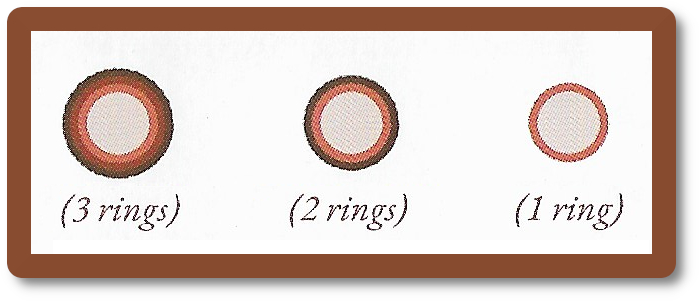 The Basics:
The Basics:
- For ages 14 and up
- For 1 to 4 players
- Approximately 30 minutes to complete
Geek Skills:
- Counting & Math
- Logical & Critical Decision Making
- Strategy & Tactics
- Hand/Resource Management
Learning Curve:
- Child – Easy
- Adult – Easy
Theme & Narrative:
- Become the world’s most successful owner of cafes that serve delicious sweet treats made from organic ingredients you grow yourself while at the same time stuffing your chicken with the leftovers
Endorsements:
- Gamer Geek mixed!
- Parent Geek approved!
- Child Geek rejected!
Overview
Beloved American cartoonist and creator of the comic strip Peanuts, Charles M. Schulz, said, “All you need is love. But a little chocolate now and then doesn’t hurt.” Oh, how very true. Whatever mood I am in or the day I am having, a delicious piece of chocolate brings a smile to my face. In this game, players are tasked to build cafes that will sell their delicious confectionaries, but their approach must also balance the need to grow the necessary ingredients and then ship them out for use. This game will challenge the players to make tough choices to make sweet deals.
Dulce, designed by Julio E. Nazario and published by Stronghold Games, is comprised of four Player boards, 96 double-sided cards (24 per player), 115 Resource cubes (that represent cocoa, coffee, peanuts, vanilla, and eggs), four Player Aid cards, four Player meeples, and four Chicken meeples. The component quality is excellent, with vibrant colors, durable bits, and easy-to-identify icons. Artist Justine Nortjé has done a fantastic job of making the components rich with detail, adding value to the game’s theme and narrative.
Setting Up Your Cafes
Complete the following steps to set up the game for two or more players.
First, give each player a Player board in the color of their choice. Then give them all the cards, the Player Aid card, the Player meeple, and the Chicken meeple that match that color. The Player board should be placed in front of the owning player. Players should take a moment to note that they start with four fully-functioning cafes at their disposal.

Second, place the Player meeple on the “Zero” space on the Player board. This is the score track. Finally, place the Chicken meeple above the “Zero” space and above the Player board. The chicken will walk around the Player board for the game’s duration, free-range style.
Third, place all the Resource cubes off to one side and within easy reach of all the players. This is the Resource pool for the duration of the game.
Fourth, select one player to be the “Lead.” This player will take their cards, shuffle them, and return four cards at the random back to the game box without looking at them or showing them to any other player. When completed, the Lead player will place their deck of cards in front of them with the “Cafe” side facing up. This is the Lead player’s draw deck. Meanwhile, all other players should take their deck of cards and ensure they are organized by the card number in ascending order. This is only necessary to help all players who are not the Lead player quickly find cards in their deck.
That’s it for game setup. Time to make some sweet treats!
How to Make Chocolate and Fat Chickens
Dulce is played in 20 rounds. Each round is divided into three phases which are summarized here.
Draw Phase
Each round begins with the Lead player drawing the top-most card from their draw deck. Then, the Lead player announced the card’s number.
All other players now look through their cards and find the same card number, removing it from their deck. The result is that all players will use the same card for the round duration.
Action Phase
While it’s true that every player will be using the same card – identical in every way except the color – how the player uses the card is an individual choice. Each player, in their own time, now decides what they want to do with the card. There are three options that are summarized here.
Option One: Build a Cafe
The “Cafe” side of the card displays the type of confection the cafe is known for at the top, including the necessary ingredients needed to make said world-famous confectionary (or delicious dessert) for customers to drool over.

If the player decides to use the card to build a cafe, they place it next to their Player board with the cafe side facing up. Every “Cafe” card will have two spaces for one of the Resource cubes. The only exception is the four cafe’s already on the Player board that only have one. To score points from the cafes (during the Scoring phase), players must have filled all the Resource spaces on the “Cafe” cards.
Option Two: Plant a Field
On the other side of the card is a field.

If the player decides to use the card to build a field in which they will grow the needed resources, they flip it to the “Field” side of the card and now place it on their Player board. The Player board is divided into squares via a grid. The “Field” card represents four squares.
When placing the “Field” card on the Player board, there are a few rules that must be followed:
- The “Field” card may be rotated in any direction as long as it entirely remains on the Player board’s grid.
- The “Field” card may be placed on top of the four starting cafes. However, doing so removes those cafes for the duration of the game.
- The “Field” card may be placed fully or partially on top of previously placed “Field” cards.
A few items to note if a player does place a “Field” card over a previously placed “Field” card.
- If the newly placed “Field” card is placed over a previously placed “Field” card with Resources, remove them now and return them to the Resource pool. The player then advances their Chicken meeple one space forward for every Resource cube removed. This is referred to as “Feeding the Chicken.”
- If the newly placed “Field” card is placed over a previously placed “Field” card so that the noted resources match, the newly established “Field” card gains a bonus Resource cube of the matching type. The previously placed “Field” card need not have the matching Resource cube located on the Player board for the player to receive this bonus.
Option Three: Harvest Crops
If the player decides that using the card this round to build a cafe or plant a field is not in their best interest, they may discard the card. Doing so allows the player to “harvest” Resource cubes in their field and move them to their cafes, including the four already built on the Player board.
The player is not able to harvest all the resources, however. There isn’t enough time in the day for that level of shenanigans. Instead, the player collects all the Resource cubes in a single row or column on the Player board. These Resource cubes are removed from their respective locations and placed in the player’s hand.
There are three levels to each resource. These are indicated by the number of rings around the resource icon. Three rings mean the resource is the highest and purest quality. UNLIMITED POTENTIAL! Two rings are of lesser value but still beneficial. One ring is the lowest quality but still permissible for use when making delicious confectionaries.

The rings inform the player – other than their quality of ingredients – how many times the Resource cube can be used.
- Any Resource cube taken from a “three-ring” space (which will always be the case when removing Resource cubes from the fields) can be placed on any “three-ring,” “two-ring,” or “one-ring” space of the same matching Resource type.
- Any Resource cube taken from a “two-ring” space can be placed on any “two-ring” or “one-ring” space of the same matching Resource type.
- Any Resource cube taken from a “one-ring” space can be placed on any “one-ring” space of the same matching Resource type.
Players now move their collected Resource cubes from the harvest to any available and valid location on their “Cafe” cards or a free cafe on their Player board. Any not used are discarded and “fed to the chicken.”
Let’s take a moment to talk about this chicken the players keep feeding.
The Chicken meeple follows the track outside the Player board and advances one space for each Resource cube the player discards. The Chicken meeple can also be moved back three spaces to create a single “Egg” Resource cube during a harvest. This unique Resource cube is considered “wild” and can be placed on any one-ring Resource space. That chicken is pretty useful, eh?
Scoring Phase
After all the players have selected one of the three options and completed them, it’s time to score the round.
Each player now looks at their “Cafe” cards and any cafes still available on their Player board. If the cafe has all the Resource spaces filled (which does include any that have the “Egg” Resource cube”), it awards the player one point. This is recorded and tracked by advancing the Player meeple on the scoring track.
If the player can score a cafe, they should pay special attention to the rings around the Resource spaces.
- If the Resource cube is located in a one-ring space or is an “Egg” Resource cube, discard it to the Resource supply. These are not used to “feed the chicken.”
- If the Resource cube is located in a two-ring space, it can be placed in any open one-ring space that matches the Resource type.
- If the Resource cube is located in a three-ring space, it can be placed in any open two-ring or one-ring space that matches the Resource type.
- If the removed Resource cube from a three-ring or a two-ring space cannot be placed in any open Resource space, it’s discarded and “feeds the chicken.”
Is everyone done? Great! Now repeat the same process and continue to do so until all cafes can be scored by moving Resource cubes around strategically. The order in which the player scores their cafes is significant and should be considered before pulling resources off and tossing them to your now obese chicken.
The Scoring phase ends when all players have completed scoring their cafes.
This concludes the round. A new round now begins with the Lead player drawing a new card.
Closing the Cafes
The game ends when the last card is played, resolved, and the round is scored. The player with the most points wins the game. If there is a tie, the players determine how many eggs their overworked chickens can lay, with victory going to the player with the most eggs.
Game Variant
The game has solo variant rules for when you want to dive into the world of sweet treats with no one around to comment on your chocolate choices. All the gameplay rules are the same, with the only exception that you determine your overall success at the end of the game by comparing your final score to a table of numbers. The table gives the player a summary of their general skill level in the game.
To learn more about Dulce, visit the game’s webpage.
Final Word
 The Child Geeks enjoyed the game’s concept but found the overall gameplay “fiddly” and “confusing.” According to one Child Geek, “I don’t think the game is hard, but I had to be repeatedly reminded how to move my cubes, reuse my cubes, and move my chicken. I felt a little stressed and now don’t like my chicken very much.” Another Child Geek said, “I like the game. I like how you can feed your chicken so you don’t lose out on what you cannot use for your chocolate shops. However, I didn’t like how much work it felt like I was doing.” Overall, the Child Geeks found Dulce to be a game they were eager to learn how to play, but found the gameplay to be troublesome almost from the get-go. They were confused about how best to use their cards, how to manage their resources, and when it was the best time to harvest. The only aspect of the game all the Child Geeks enjoyed was the chicken, which they found very amusing. As a result, the Child Geeks gave Dulce a miss when the final vote was in.
The Child Geeks enjoyed the game’s concept but found the overall gameplay “fiddly” and “confusing.” According to one Child Geek, “I don’t think the game is hard, but I had to be repeatedly reminded how to move my cubes, reuse my cubes, and move my chicken. I felt a little stressed and now don’t like my chicken very much.” Another Child Geek said, “I like the game. I like how you can feed your chicken so you don’t lose out on what you cannot use for your chocolate shops. However, I didn’t like how much work it felt like I was doing.” Overall, the Child Geeks found Dulce to be a game they were eager to learn how to play, but found the gameplay to be troublesome almost from the get-go. They were confused about how best to use their cards, how to manage their resources, and when it was the best time to harvest. The only aspect of the game all the Child Geeks enjoyed was the chicken, which they found very amusing. As a result, the Child Geeks gave Dulce a miss when the final vote was in.
 The Parent Geeks, on the other hand, were enthralled by Dulce. According to one Parent Geek, “I found the game to be a very relaxing and engaging game of solitary play with friends. They didn’t mess with my plans, and I didn’t mess with theirs. The game was complex enough to keep me hooked and thinking, but it also was very casual in its approach. And oh my goodness, did I overfeed my chicken! Loved the game.” Another Parent Geek said, “A great game for my friends and I, or just the wife and I with a glass of wine and soft music in the background. Every round is meaningful and enjoyable. I very much enjoyed myself and would play this game again, as well as recommend it to friends.” When the last cafe was closed, all the Parent Geeks agreed they couldn’t wait until they opened again, fully approving Dulce.
The Parent Geeks, on the other hand, were enthralled by Dulce. According to one Parent Geek, “I found the game to be a very relaxing and engaging game of solitary play with friends. They didn’t mess with my plans, and I didn’t mess with theirs. The game was complex enough to keep me hooked and thinking, but it also was very casual in its approach. And oh my goodness, did I overfeed my chicken! Loved the game.” Another Parent Geek said, “A great game for my friends and I, or just the wife and I with a glass of wine and soft music in the background. Every round is meaningful and enjoyable. I very much enjoyed myself and would play this game again, as well as recommend it to friends.” When the last cafe was closed, all the Parent Geeks agreed they couldn’t wait until they opened again, fully approving Dulce.
 The Gamer Geeks enjoyed the mechanics but came at it from a different direction. According to one Gamer Geek, “A solid game that I would recommend to casual players, but I found myself a bit bored due to the game’s lack of player interaction and competition. I would describe this as a solo game you play with friends. Even the solo rules are the same as playing the game with two or more players. It was an interesting game, but not one I would request to play again, but I would play it again with the family.” Another Gamer Geek said, “I can see this game being very popular with the casual players, but for those of us who want to interact with others, foil our opponent’s plans, and hungrily fight over limited resources, the game fell well short of the mark. Highly recommend it for the casual crowd and those who like a solitaire game you play with friends, but elitists will find little to be excited about.” When our hungry gaming elitists devoured the last chocolate, they found that Dulce left them hungry for more but not altogether disappointed. The result was a mixed review.
The Gamer Geeks enjoyed the mechanics but came at it from a different direction. According to one Gamer Geek, “A solid game that I would recommend to casual players, but I found myself a bit bored due to the game’s lack of player interaction and competition. I would describe this as a solo game you play with friends. Even the solo rules are the same as playing the game with two or more players. It was an interesting game, but not one I would request to play again, but I would play it again with the family.” Another Gamer Geek said, “I can see this game being very popular with the casual players, but for those of us who want to interact with others, foil our opponent’s plans, and hungrily fight over limited resources, the game fell well short of the mark. Highly recommend it for the casual crowd and those who like a solitaire game you play with friends, but elitists will find little to be excited about.” When our hungry gaming elitists devoured the last chocolate, they found that Dulce left them hungry for more but not altogether disappointed. The result was a mixed review.
 I found Dulce to be a game I loved with my wife and one I wouldn’t want to play with my youngest children. Not because they couldn’t figure out the rules – they are very good at picking up games – but due to how the game evolves. You have to play cards over cards and move small cubes a little to the left or a little to the right. Game mechanic-wise, I loved it. However, as a parent who knows full well how messy this game can be in the hands of little fingers, it was a headache. Too often, the cards moved in the fields, or the Resource cubes shifted wrong. The result was a game in which our littlest and less detail-orientated Child Geeks became confused and frustrated rather than enjoying it to the intended level.
I found Dulce to be a game I loved with my wife and one I wouldn’t want to play with my youngest children. Not because they couldn’t figure out the rules – they are very good at picking up games – but due to how the game evolves. You have to play cards over cards and move small cubes a little to the left or a little to the right. Game mechanic-wise, I loved it. However, as a parent who knows full well how messy this game can be in the hands of little fingers, it was a headache. Too often, the cards moved in the fields, or the Resource cubes shifted wrong. The result was a game in which our littlest and less detail-orientated Child Geeks became confused and frustrated rather than enjoying it to the intended level.
That said, the game went off very well for the older crowds, who were more inclined to keep a structured and clean approach to managing their Player board. But only to a point. Those who wanted more action beyond their Player board kept looking for opportunities to mess with their opponents or to gain a significant advantage. To which there is none. The lack of player interaction disappointed all our Gamer Geeks and a few of the Parent Geeks. However, in this case, the Parent Geeks didn’t much mind, while the Gamer Geeks felt that lack of player interaction meant the game was nothing more than a solitaire game.
Which it is.
Dulce is a solitaire game you can play with friends that is purposeful and wonderful. Not every game needs to be cutthroat and in your face, and thank goodness for that. As much as I enjoy games with heavy player interaction, intense competition, and gut-wrenching envy of my opponent’s ability to manage the game board, I also need those games where I can lean back, play the game, have a great conversation, sip my beer, and laugh with friends and family while also playing a board game I love. Dulce is that kind of game. It gave me all I wanted for a solitaire game and opened itself to friendly banter at the table while we all overfeed our poor chickens.
My favorite aspect of the game was evaluating each round with intense interest in how best to score points and creating a system in which points would continue to be scored quickly, which is surprisingly hard. Every player is given the same card to ponder, but their choice of how to use it is entirely up to them. I enjoyed watching my opponents use their cards differently, which informed me of their possible direction in the game and opened my mind to new possible approaches. I always find it very interesting to see how other peoples’ minds work, and Dulce allowed me to observe, ask questions, and learn a great deal about how my friends and family think (which I might or might not be recording for later use in other games).
I enjoyed Dulce and continue to enjoy the game. According to my wife, the Mama Geek, “The game was just the right mix of casual relaxation and engaging mechanics to keep me hooked. It also made me hungry for chocolate.” Which is very accurate. We talked a great deal about the various confectionaries we enjoyed while quaffing our beer and planting our fields. Meanwhile, our somewhat obese and unhealthy chickens lay in the yard, struggling to move and breathe. Poor cluck-clucks.
If you are in the mood for a game where all the players are working towards the same goal but don’t get in each other’s way, a playing style that is casual and fun, using game mechanics that give you more control than you think possible (including feeding a chicken), then do play Dulce when the opportunity presents itself. If you are like me and enjoy a game from time to time that lets you relax and have engaging fun, I think you’ll find Dulce delicious.
This game was given to Father Geek as a review copy. Father Geek was not paid, bribed, wined, dined, or threatened in vain hopes of influencing this review. Such is the statuesque and legendary integrity of Father Geek.



